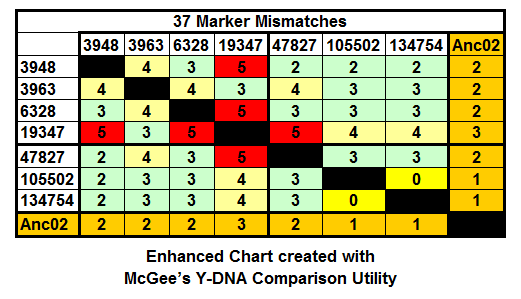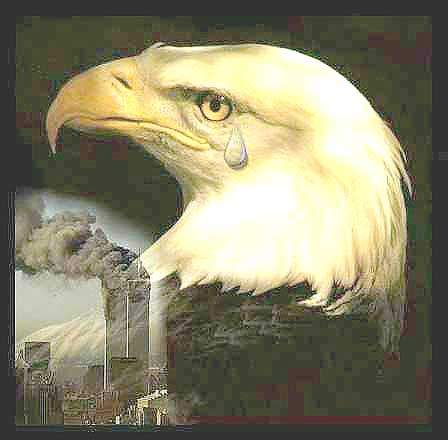

BLAIR DNA Project

DNA 103: Grouping Participants
DNA 103: Grouping Participants
Placing your participants into various groups based on their DNA test results is one of the most important things a Project Administrator can do. I strongly recommend that you start doing this as soon as matches start to appear. As your project grows it becomes much easier to add new matches to an existing group or start a new group.
I group participants primarily based on the strength of their DNA match, but I also consider their paper trail to a lesser degree.
Strength of the DNA Match
The Strength of the DNA Match depends on:
-
The Number of Markers Tested
-
The Number of Marker Matches
-
Unusual Marker Values
A 36 for 37 marker match with a rare value on one or more of the markers is a stronger match than a 24 for 25 marker match with common values on all the markers.
Markers Tested - Markers Matched
-
Minimum of 25 Markers Tested
I normally only group participants who have tested at least 25 markers. I will include a participant with only 12 markers if he is an exact match and shares a known common ancestor with someone who is already included in a group. -
~50% Probability of sharing a common ancestor within 12 generations
As a rule of thumb I consider two participants to be a match if there is about a 50% chance they share a common ancestor within 12 generations. I use FTDNATip and normally consider the following a match close enough to include in a group:-
23 of 25 markers = 48.6 - 54.2% probability they share a common ancestor within 12 generations
-
33 of 37 markers = 53.6 - 59.2% probability they share a common ancestor within 12 generations
-
61 of 67 markers = 44.2 - 48.5% probability they share a common ancestor within 12 generations
-
McGee�s Y-DNA Comparison Utility
As groups grow in size it becomes increasingly more difficult to calculate all the marker mismatches between members of a group. Fortunately there is an online utility that will do all the number crunching for you. McGee�s Y-DNA Comparison Utility allows you to copy data from a spreadsheet or other source, paste it into the program, and produce a chart like the one shown here.

This particular chart has been somewhat enhanced but the McGee program gives you all the data in an almost identical format.
By creating this matrix you can see the exact number of mismatches between any two participants.
Note that in addition to the 7 actual participants, I�ve included a hypothetical Anc02.
Ancestral Haplotype
One of the things I do for each of my groups is create an Ancestral Haplotype for that group. He�s known as Anc01 or Anc02, etc and is the hypothetical "common ancestor" of the participants in the Group.
Although it�s impossible to know his actual DNA results, it is possible to deduce his most likely test results based on the results of his descendants. In its simplest form the ancestral haplotype is simply the most frequent marker values of the participants in the group.

The example above illustrates the ancestral haplotype of 4 factious participants. Note that although each participant mismatches the other participants on 2 markers, they all match the hypothetical ancestor on 24 of 25 markers.
As you add more participants to a group it is possible that the ancestral haplotype will change. If a group contains a large number of participants who share a known common ancestor with a distinct marker value you may have to make adjustments so you do not skew the haplotype.
Unusual Marker Values
Sharing a rare value on one or more of your markers can be a strong indication that participants share a common ancestor, provided the rest of their DNA results support that conclusion. It can be especially valuable in the case of borderline groupings.
In Group 3 of the Blair DNA Project we have 17 participants with a value of 26 on DYS#390 which occurs only about 1% of the time. 14 of these same participants also have values of 12/14 on DYS#385a/b which occurs less than 4% of the time.
Several websites have developed frequency distributions for the various marker values. I�ve included the website address of the sites listed here at the bottom of the page. I used the Sorenson Molecular Genealogy Foundation Website.
Conventional Research
One of the major reasons for DNA testing is to either support or refute conventional research. So using conventional research to place someone in a DNA group may seem illogical. Conventional research should ONLY be used as a tie breaker.
No matter how good the paper trails may be, if the DNA results don�t match, I won�t put the participants in the same group.
But what if the DNA results are inconclusive or borderline? Then I look at the conventional research.
-
Do the participants claim to share a common ancestor?
-
If so, how far back is this common ancestor?
-
How complete are their paper trails?
-
Are there any inconsistencies in their paper trails that would make them suspect?
Whether I include them in the same group depends on the answers to all of these questions.
Sometimes instead of asking �What is the probability that these two participants ARE related?� it�s better to ask the question �What is the probability that these two participants are NOT related?� |
DNA 102: Interpreting DNA Test Results
DNA References for
Grouping Participants
McGee�s Y-DNA Comparison Utility - http://www.mymcgee.com/tools/yutility.html
Frequency Distribution of Marker Values
Sorenson Molecular Genealogy Foundation (SMGF) - Y-Chromosome Marker Details - http://www.smgf.org/ychromosome/marker_details.jspx
Y-Base Statistics - http://www.ybase.org/statistics.asp
Leo Little data from FTDNA data and Y-search - http://freepages.genealogy.rootsweb.ancestry.com/~geneticgenealogy/yfreq.htm
|
� July 12, 2010, blairdna.com |
This WebPage was last updated 04/05/2015
|
Custom Web Search Search Genealogy, DNA, and Genetic Genelogy websites |
|
Custom Web Search Search Genealogy, DNA, and Genetic Genelogy websites |
| Contact the Blair DNA Project Coordinator |
© January 1, 2010, blairdna.com

God Bless
America
and its Allies